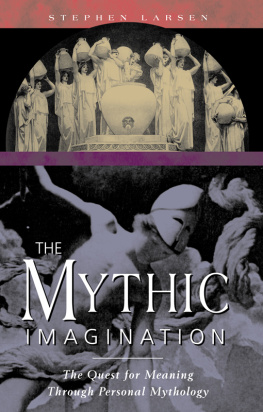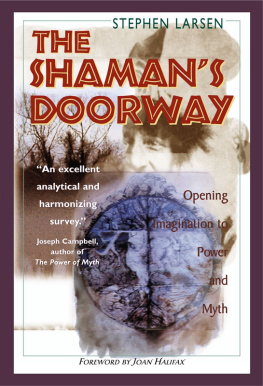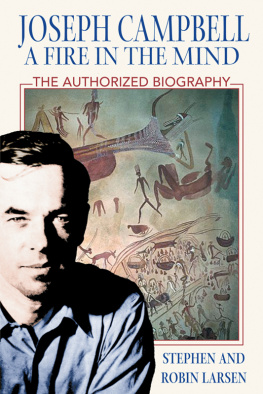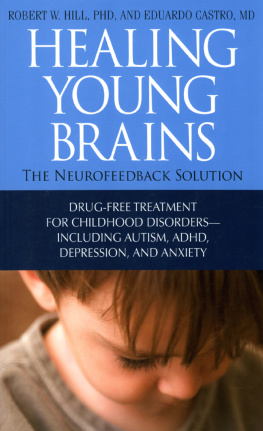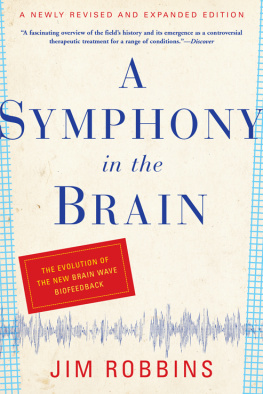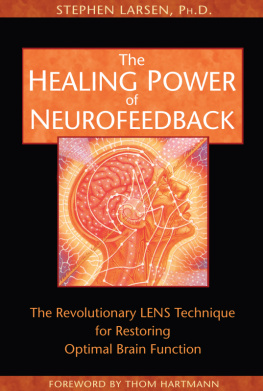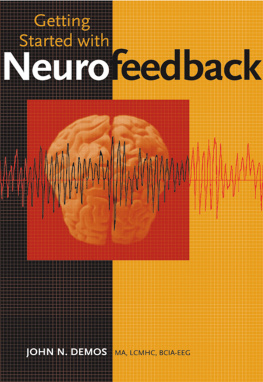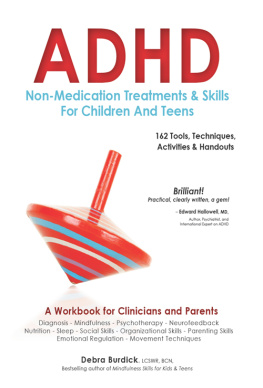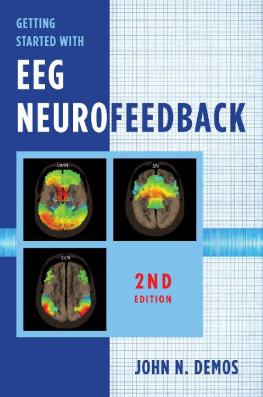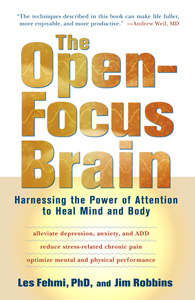
This book is dedicated to three of the great pioneers and innovatorswhose lives spanned the twentieth century and who lived into the twenty-firstwho have made our field possible:
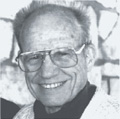
Elmer Green, who first hooked up yogis and explored the boundaries of science and mysticism.
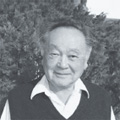
Joe Kamiya, who discovered brain wave discernment and thus empowered a new discipline for Psychology.

Hershel Toomim (right), who invented machines, both practical and healing, to bring new dimensions to biofeedback therapy.
THE NEUROFEEDBACK SOLUTION
Clearly written and exciting in scope. The contributors assembled here represent the whos who in research-based neurofeedback. They pioneered the use of sophisticated technology and developed effective protocols to treat a variety of disorders.
LES FEHMI, PH.D., DIRECTOR OF THE PRINCETON BIOFEEDBACK CENTRE, DEVELOPER OF OPEN FOCUS TRAINING, AND AUTHOR OF THE OPEN-FOCUS BRAIN
This book comes close to having it all: the past, present, and future of neurofeedback and neuroplasticity; the theories; and the stories of real people who, using neurofeedback and related technologies, discover and rediscover their true humanity and higher functioning. Here is the humanity with the technologies, and the technologies with the humanity.
LEN OCHS, PH.D., FOUNDER OF OCHSLABS AND THE LENS TECHNIQUE
The brain can do far more for itself than drugs or other invasions, and the possibilities and realities are brought forth herein. The wisdom to self-regulate is contained in every brain. Larsen introduces a host of pioneers who are forging the future in this important emerging discipline.
THOMAS COLLURA, PH.D., BIOMEDICAL ENGINEER, NEUROPHYSIOLOGIST, AND FOUNDER AND PRESIDENT OF BRAINMASTER TECHNOLOGIES
Stephen Larsen has done an amazing job of pulling together state-of-the-art neurofeedback treatments into an easy-to-read book that will be useful to experts in the field as well as the general public. Those already doing neurofeedback as well as those with no background at all can learn from this book.
JEFFREY A. CARMEN, PH.D., LICENSED PSYCHOLOGIST AND CREATOR OF THE EZPIR HEG NEUROFEEDBACK SYSTEM
FOREWORD
Nancy White, Ph.D., and Leonard Richards, Th.D.
I n his second book about neurofeedback, Stephen Larsen takes us further into the fascinating odyssey of this promising field: its birth, its adolescence, and now the dawn of its emergence into a mature treatment modality. The story the author tells us here is far from the final chapter in this rapidly developing discipline, and his current work chronicles significant aspects of neurofeedbacks grown-up life: what it has become and what it can do today. Attention is duly given to the knowledge, understanding, and inventiveness that current practitioners have gained by going to school for a generation, under the tutelage of the fields original researchersto whom this book is dedicated. Like Dad finally giving us the keys to our own car, todays practitioners are taking the results of their mentors toil and driving more skillfully and safely into the future.
Important research findings in neural science regarding the physiology and functioning of our brains corroborate and support the findings of neurofeedback researchersconducted for the most part without the extravagant funding available for more conventional projectsto provide an evidence-basis that gives the field greater acceptance than ever before. Stephen Larsen chronicles some of these developments, devoting an entire chapter (chapter 2) to the mainstream neuroscientific underpinnings of neurofeedback.
This field didnt always have the level of acceptance it does today. I (Nancy White) was one of the first professionals who brought neurofeedback from research into daily clinical practice; this began in the 1970s. Back then, many in the medical establishment treated neurofeedback with disdain, if not outright derision. On more than one occasion a parent reported to us that her childs pediatrician told her not to bother with neurofeedback because she was wasting her money. They found otherwise when they proceeded with neurofeedback therapy and their children improved markedly. At the end of an interview we gave to Houstons business newspaper in the mid-1990s, a well-known local psychiatrist was asked to comment; he laid waste to the entire article with his own relatively uninformed negativity. But today an entire section of his practice is devoted to neurofeedback.
On another occasion in the early 1990s we attended a dinner party in the elegant gardens of a friends home. At our table sat a much older couple; the man introduced himself as a neurologist who remembered Houstons venerable Medical Center when it was a corn field. At some point in the conversation he turned to me and asked, And what is it you do, my dear? I replied that we trained peoples brains to improve neural function, at which point the old doctor pulled his glasses down on his nose and with a stern look said, Poppycock, my dear, you cant train brains!
Today, neurofeedback is conducted on a small scale at Baylor College of Medicine in Houston and at the University of Texas Medical Branch in Galveston. In our own clinic, we offer a variety of neurofeedback and related treatment modalities to improve brain functionin cases ranging from ADHD through traumatic brain injury to Aspergers and autism. How we use these modalities is guided by a wide range of testing and diagnostic tools, recently developed but increasingly accepted as reliable in the mental health professions.
Were a long way from the old-fashioned brown box with the 1970s blinking light, which signaled feedback. Todays venues may be the similar but the conversations are growing in sophistication and confidence. Thats how far the field of neurofeedback has come and thats how much the rapidly growing body of research gives evidence of its efficacy.
And outcomes of this marvelous adventure are what Stephen Larsen gives us in this book.
More than a sequel to his earlier work, The Healing Power of Neurofeedback, this offering, The Neurofeedback Solution, takes us much further, much deeper, into this fascinating field. The distinguished professional contributors in this volume lay out salient aspects of todays neurofeedback in detail, but they do so in an accessible and conversational tone, despite the technical details included. Were introduced to a spectrum of areas in which neurofeedback has shown itself to be truly helpful. We believe neurofeedback can be life-changing, for ourselves, for loved ones, and for the many people so obviously helped by it, from difficult conditions otherwise unresponsive to conventional treatments.
At the very end of this book, we are given brand new perspectives on the mysterious field of consciousness itselffrom a neurofeedback perspectivewith Stephen interviewing some of the foremost brain wave experts in the world; they help us to understand the relationship between the brain and human behavior, at ever-deeper levels. This entire book gives both detailed science and warm and engaging human wisdom on how our minds work and how we can heal ourselves. You can trust that the science is sound, but you will not bog down in its details, because the overall message is so accessible and so universally human.
Next page

